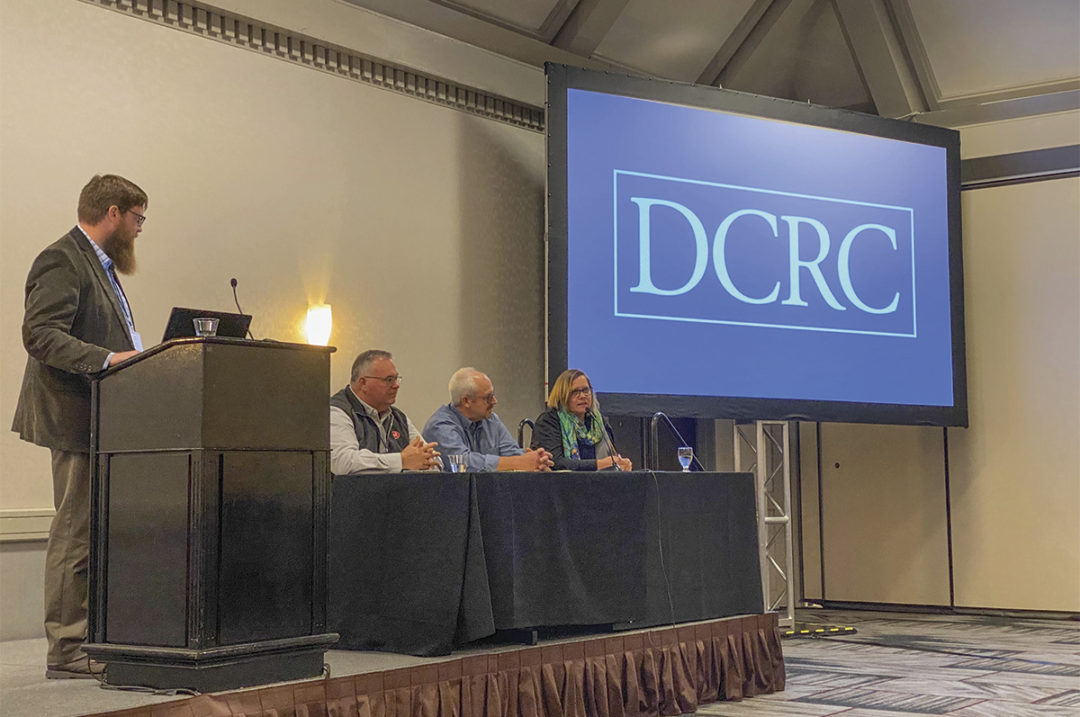To read this article in French, click here.
“Change is easy. Transition is hard. Are you open to surrounding yourself with people who have the best knowledge and listening to them?” Nancy Charlton of DeLaval asked listeners of the “Capitalizing on robotics to enhance animal health and reproduction” panel at the 2023 Dairy Cattle Reproduction Council annual meeting.
Charlton joined Dan Meihak of Lely and John Gerbitz of Cow Corner as the three experts fielded questions from the audience that were fielded by moderator Matt Utt of Zoetis during the November conference.
Though the panel primarily focused on reproduction management, questions ran the whole gamut during the session – from inquiries regarding successful operations to preparation for installing robots, cow comfort and more. Here’s a glance at the conversation surrounding reproductive management in a robotic facility.
What reproductive programs work best in robotic herds?
 CHARLTON: I would never ask someone to move away from a successful Double Ovsynch or a successful Presynch program. I would caution people who are "going robotic" who think “I’m getting out of the barn and everything is going to be au naturel.” If it’s going to be au naturel, you better have an awesome transition cow program. You better be selling milk to soccer moms and getting a good milk price because people I respect say the maximum pregnancy rate you can achieve with no fertility products is 20%.
CHARLTON: I would never ask someone to move away from a successful Double Ovsynch or a successful Presynch program. I would caution people who are "going robotic" who think “I’m getting out of the barn and everything is going to be au naturel.” If it’s going to be au naturel, you better have an awesome transition cow program. You better be selling milk to soccer moms and getting a good milk price because people I respect say the maximum pregnancy rate you can achieve with no fertility products is 20%.
Sit down with a good team and ask questions. What are your expectations? What does your transition cow program look like? Once you have minimal body condition score loss, your conception rates are where you want them to be. You must understand what you’re capable of.
 GERBITZ: There is no one program that works in all situations. If I’m working with a farm that’s had a highly successful Double Ovsynch protocol, I’m not going to advise them to move away from what’s worked for them. Especially as we’re moving into the [robotic] technology, we should change as few things as possible. It’s my job to figure out how we’re going to get the cows where we need them to continue with that Double Ovsynch protocol.
GERBITZ: There is no one program that works in all situations. If I’m working with a farm that’s had a highly successful Double Ovsynch protocol, I’m not going to advise them to move away from what’s worked for them. Especially as we’re moving into the [robotic] technology, we should change as few things as possible. It’s my job to figure out how we’re going to get the cows where we need them to continue with that Double Ovsynch protocol.
 MEIHAK: I work with producers across the spectrum. Some handle their reproductive management the same way they did or do in a conventional system. In preparing for this discussion, I made a few phone calls to some people who have changed the way they do things. One dairy implements a Double Ovsynch protocol in their conventional barn, and in the robot barn, they use selected Ovsynch on cows that reach a certain threshold. They’ve cut their drug use by about 75% in the robot barn compared to the conventional barn; pregnancy rates are the same.
MEIHAK: I work with producers across the spectrum. Some handle their reproductive management the same way they did or do in a conventional system. In preparing for this discussion, I made a few phone calls to some people who have changed the way they do things. One dairy implements a Double Ovsynch protocol in their conventional barn, and in the robot barn, they use selected Ovsynch on cows that reach a certain threshold. They’ve cut their drug use by about 75% in the robot barn compared to the conventional barn; pregnancy rates are the same.
Another guy I talked to – a 30-robot herd – has dropped his drug use by 93% and has lost two points of preg rate – 29% to 27%. I asked him if that was all right with him and he said, “I’d gladly lose those two percentage points to give up the 93 percent of drug use.”
I think it’s all about the potential that is there with these systems. Let’s say you’ve got a herd that averages 2.8 milkings per day. Theoretically, every cow in the herd is getting milked every 8.5 hours. If you set a sort for cows with a heat attention to sort for 8.5 hours and the breeder comes in at 8 a.m., those cows are there for him. It’s really kind of an elegant design. I’m trying to connect the dots in my mind and see what’s so complicated about this or what’s different, and it’s really not.
What problems and opportunities arise with a reproductive program when switching from a conventional to a robotic dairy?
CHARLTON: In a parlor world, you’re going to talk to your nutritionist about how you want to feed cows. And if cows don’t get pregnant or you have stale cows, you’re not calling DeLaval because the cows aren’t eating enough in the parlor. I guess there’s a question in front of me about first-service conception rate, and particularly in free flow and the traditional ways of feeding we need those nutrients in the cows to maintain body condition and cow health. We spend a lot of time in that area, whereas if cows are not maintaining their body condition in a rotary parlor, no one is calling DeLaval. There’s an indirect influence there.
GERBITZ: Sorting those cows and having them available. Understanding that we need to know eight to 12 hours beforehand which cows we need to make available. In a rotary, I can look at a report from an activity system before that group heads to the parlor and I know what time those cows will be in the parlor. I can make my decision pretty much within an hour or two of when I want that cow available. At the robot barn – regardless of the protocol – I need to be thinking of the cows that I need eight to 12 hours before I see them. That’s one of the challenges I see.
MEIHAK: I think the people who struggle with reproductive management on a robotic dairy are trying to manage it the same way they do with a conventional system. That means they’re locking up cows, spending a lot of time in the pen interfering with a free flow, guided or hybrid-type flow system; if you’re in there interfering with cows, you’re creating a bottleneck. It creates a disturbance and is going to have a huge impact on overall performance.
What are the greatest technologies that could be included with a robotic milking system to improve reproductive performance?
CHARLTON: I want magical software to appear on the monitor when you walk in the barn that says: Here are the cows you need to look at, cows you need to do something with and cows you need to sell right now. I want an index that’s going to make you ask: Why is this cow in my herd? Efficiencies are the name of the game. We don’t want those cows that are reproductively high-performing to be dragged down by cows that shouldn’t be in the herd. How can we use information to actually influence change? There will be all kinds of sensors for us, but bringing that data together and having those numbers you want to look at each day – then you can make decisions and actions happen.
GERBITZ: I think I’ll be looking for tools that help prepare cows for the robot, pre-training tools. It’s so important that when cows come into that robot pen they are eating robot pellet, that they’re finding their way to the bunk and natural cow flow.
MEIHAK: Activity monitoring systems and adding progesterone testing to those systems. I think that’s going to come into play. I also think there are things that can enhance cow welfare from a genetic trait standpoint. We track robot visits by individual cows, and we see cows that are of the same parity, in the same pen, under the same feed management system, same everything. One of those cows goes to the robot on a regular basis. The other one visits the robot irregularly. It plays into the circadian rhythm, and I don’t fully understand that, but my question is – why? That’s a behavior trait and should be relatively heritable. What’s in that cow that prevents her from visiting the robot regularly versus her herdmate who is? I think that’s something that really has potential. I also think information on the rate of udder fill versus capacity could help reduce bimodal milking.
To listen to the full discussion and additional conference sessions, visit the DCRC website.






